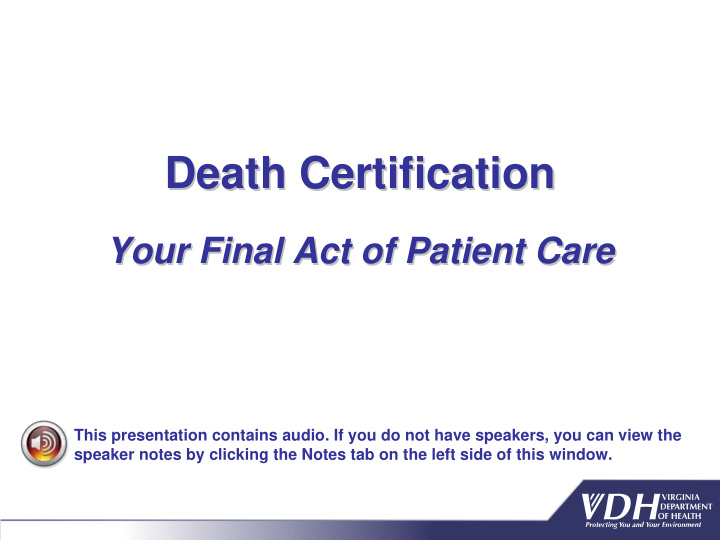



Death Certification Death Certification Your Final Act of Patient Care Your Final Act of Patient Care This presentation contains audio. If you do not have speakers, you can view the speaker notes by clicking the Notes tab on the left side of this window.
What is a Death Certificate? What is a Death Certificate? • Permanent legal record of vital information • Includes: – Demographic information – Circumstances, cause and manner of death – Date and place of interment or disposition – Names of next of kin
Who Uses the Death Certificate? Who Uses the Death Certificate? • Family • Virginia Department of Health • Many national, state, and local agencies
Virginia Code § § 32.1 32.1- -263(C) 263(C) Virginia Code The medical certification portion of the death certificate shall be completed, signed in black or dark blue ink, and returned to the funeral director within 24 hours after death by the physician in charge of the patient’s care for the illness or condition which resulted in the death except when inquiry or investigation by medical examiner is required, or by the physician that pronounces death.
Who is the “physician in charge of patient’s care at the time of death”?
Who Else May Sign? Else May Sign? Who • In absence of treating or pronouncing physician: – Practice partner/covering physician – Vice-President for Medical Affairs or Medical Staff President as the Chief Medical Officer of the medical institution where death occurred – Physician who performed the autopsy
When to Call Medical Examiner? When to Call Medical Examiner? • Deaths involving: – Any injury, trauma, or poisoning – Person not under physician care – Unexplained, suspicious or unnatural deaths – Persons who die in correctional or state mental health institutions • Any other concerns
How to Complete a Death Certificate How to Complete a Death Certificate • Green border form • For natural deaths only • Responsible for: – Name of Decedent – Sex – Date of Death – Medical Certification (Section 28)
General Instructions General Instructions • Should be typed or written legibly • Use black or dark blue permanent ink • Press very HARD so all copies will be legible • No corrections, erasures, whiteout
Medical Certification Section Medical Certification Section • Use your best medical judgment • Use broad categories of disease if unsure • Contact local health director or district medical examiner’s office for advice
Medical Certification Section Medical Certification Section Part I: Cause of Death
Medical Certification Section Medical Certification Section Part II: Other Significant Conditions
Scenario 1 Scenario 1 Cynthia was found dead, sitting on a couch in her home by her daughter. She was 76 years old and was last known to be alive the previous evening and complained of being tired. The police contact you to certify the death. You review her records which show she is being treated for hypertension and 2 years ago suffered a stroke leaving her with residual hemiparesis of her right arm. You are her primary care physician. How would you certify this death?
Scenario 1 Scenario 1 Complications of hypertension Myocardial infarction Coronary artery thrombosis Coronary atherosclerosis Atherosclerosis
Scenario 2 Scenario 2 Bob, a 52 year old man, was raking leaves outdoors and began having chest tightness and trouble catching his breath. He told his wife who immediately took him to the hospital. In the emergency department, the EKG showed changes indicative of ischemia. On the way to the cardiac catheterization lab, he arrested and expired. You are the emergency department physician. How would you certify this death?
Scenario 2 Scenario 2 Acute myocardial infarction Atherosclerotic cardiovascular Disease
Scenario 3 Scenario 3 You are called to the ICU. Mary, a 56 year old woman that you have cared for the past two weeks, has just died. Mary presented with jaundice, pain and fever and was taken to the operating room to remove a gangrenous gallbladder. At this time a peripancreatic abscess was identified and drained and she was placed on an appropriate antibiotic.
Scenario 3 Scenario 3 Following the surgery, Mary had an overall downhill course complicated by renal failure, respiratory problems and anemia. As a hospitalist, how would you certify this cause of death?
Scenario 3 Scenario 3 Multiple medical complications Gangrenous cholecystitis with peripancreatic abscess Cholelithiasis
Scenario 4 Scenario 4 You are called to certify the death of Ann, a 96 year old woman with dementia, who was found dead in bed at the nursing home she has lived in for many years. Her only medication is hydrochlorothiazide, in low dose that she has been taking for years. The nursing staff say "she has been slowing down" but has no other recent illnesses or complaints. You are the nursing home physician. How would you certify this death?
Complications of dementia Scenario 4 Scenario 4 Hypertension
Where to Get Assistance? Where to Get Assistance? • Instructions for Completing Death Certificate for Natural Causes • Local Health District Directors http://www.vdh.virginia.gov/lhd/ • Office of the Chief Medical Examiner District Offices http://www.vdh.virginia.gov/medExam/ContactUs.htm
Your Final Act of Patient Care Your Final Act of Patient Care
Recommend
More recommend